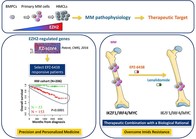Biomarkers for targeted therapy of high-risk MM patients with EZH2 inhibitors in combination with IMiDs
Référence
09688-01
Statut des brevets
European priority patent application n° EP16306436.3 filed on on November 02, 2016, entitled « Methods for predicting response to EZH2 inhibitors in Multiple Myeloma»
Inventeurs
Jérôme Moreaux et al.
Statut commercial
Exclusive license, collaborative research agreement
Laboratoire
Institut de Génétique Humaine (Institute of Human Genetics), CNRS UMR9002, Montpellier, France
Description
CONTEXT
Multiple Myeloma is a B cell neoplasia characterized by the accumulation of clonal plasma cells within the bone marrow. Epigenetics is characterized by a wide range of changes that are reversible and orchestrate gene expression. Recent studies have shown that epigenetic modifications play a role in Multiple Myeloma (MM) by silencing various cancer-related genes. We investigated the epigenetic genes differentially expressed between normal bone marrow plasma cells and MM plasma cells from patients (N=206) and identified the overexpression of EZH2 histone methyltransferase in MM. EZH2, the enzymatic subunit of Polycomb Repressive Complex 2, is a histone methyltransferases able to repress gene expression by catalyzing H3K27me3 histone mark. EZH2 expression was analyzed in normal bone marrow plasma cells (BMPCs; N=5), primary myeloma cells from newly diagnosed patients (MMCs; N=206) and human myeloma cell lines (HMCLs; N=40) using Affymetrix microarrays. EZH2 gene is significantly overexpressed in MMCs of patients compared to normal BMPCs (P < 0.01). The expression is even higher in HMCLs compared to primary MMCs or BMPCs (P < 0.001). High EZH2 expression is associated with a poor prognosis in 3 independent cohorts of newly diagnosed patients. Specific EZH2 inhibition by EPZ-6438 EZH2 inhibitor induced a significant decrease of global H3K27me3 in all the HMCLs tested (P < 0.01) and inhibited MM cell growth in 5 out of the 6 HMCLs tested. The inhibitory effect of EZH2 inhibitor on MM cell growth appeared at day 6 suggesting that it is mediated by epigenetic reprogramming. To confirm that EZH2 is also required for the survival of primary MMCs from patients, primary MM cells (n = 17 patients) co-cultured with their bone marrow microenvironment were treated with EPZ-6438. As identified in HMCLs, EZH2 inhibition significantly reduced the median number of viable myeloma cells (P = 0.004) from a subset of patients (n=9) while the other group (n=8) was resistant. Of interest, EPZ-6438 induced a significant global H3K27me3 decrease in both groups of patient. RNA sequencing of 6 HMCLs treated with EPZ-6438 combined with H3K27me3 ChIP analyses allowed us to create an EZ GEP-based score able to predict HMCLs and primary MM cells sensitivity to EZH2 inhibitors. We also observed a synergy between EPZ-6438 and Lenalidomide, a conventional drug used for MM treatment. More interestingly, pretreatment of myeloma cells with EPZ-6438 significantly re-sensitize drug-resistant MM cells to Lenalidomide. Investigating the effect of EPZ-6438/Lenalidomide combination in MMC, we identified that IKZF1, IRF4 and MYC protein levels were significantly more inhibited by the combination treatment (65.5%, 63.9% and 14.8% respectively) compared with Lenalidomide (51.5%, 43% and 2.2%) or EPZ-6438 (45.2%, 38.7% and 6.2%) alone.
TECHNICAL DESCRIPTION
We developed a GEP-based score that allows to identify high-risk MM patients that could benefit from EZH2 inhibitor treatment and identified a synergistic effect in combination with immunomodulatory agents.

| EZH2 is over expressed in MM in association with a poor prognosis and represent a potent erapeutic target. We developed a GEP-based score that allow to identify high-risk MM patients that could benefit from EZH2 inhibitor treatment and identified a biological rationale to combine EZH2 inhibitor with immunomodulatory agents (Imids) in MM. |
DEVELOPMENT STAGE
Validation in vitro with a unique collection of human myeloma cells and with primary myeloma cells from patients cocultured with their bone marrow microenvironment.
BENEFITS
Clinical trials are ongoing with EZH2 inhibitors in lymphoma and could be promising for a subgroup of MM patients in combination with IMiDs. Furthermore, the EZ score enables identification of MM patients with an adverse prognosis and who could benefit from treatment with EZH2 inhibitors.
INDUSTRIAL APPLICATIONS
This technology could be used as a biomarker for targeted therapy of high-risk MM patients with EZH2 inhibitors in combination with IMiDs.